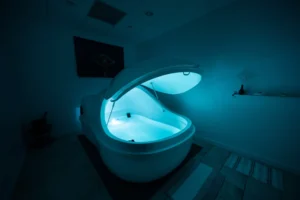In an era where the buzz of technology and the pace of modern life often leave us feeling overwhelmed, float therapy emerges as a serene antidote to the stress and anxiety that pervade our daily existence. This transformative wellness practice, rooted in the principles of sensory deprivation, offers a unique pathway to tranquility. This article explores the burgeoning body of research underscoring the efficacy of float therapy in mitigating stress and anxiety, illuminating why this silent treatment is speaking volumes in the realm of mental health.
The Science of Sensory Deprivation
Float therapy, also known as Restricted Environmental Stimulation Therapy (REST), involves an individual lying in a float tank filled with a solution of water and Epsom salts, creating a buoyant environment that allows for effortless floating. Engineered to minimize external stimuli, this environment reduces sensory input to the brain, a state that proponents argue can lead to profound relaxation and therapeutic benefits.

Unraveling the Stress Response
Central to the appeal of float therapy is its reported ability to downregulate the body’s stress response. A study published in the American Journal of Health Promotion found significant reductions in cortisol levels, a key biomarker of stress, in individuals after a session of float therapy. Cortisol, often dubbed the ‘stress hormone,’ plays a crucial role in the body’s fight-or-flight response, and elevated levels over time can lead to a host of health issues, including anxiety, depression, and sleep disturbances.
Float Therapy and Anxiety Relief
The tranquil confines of the float tank have also shown promise in alleviating symptoms of anxiety. Research in the journal BMC Complementary Medicine and Therapies delineates how float therapy can serve as an effective intervention for anxiety disorders, including Generalized Anxiety Disorder (GAD). Participants in these studies reported a significant decrease in anxiety levels, with effects comparable to those of traditional therapeutic approaches like Cognitive Behavioral Therapy (CBT).
The Neurological Pathway to Peace
Delving deeper into the neurological impact of float therapy, studies highlight its ability to induce a state of deep relaxation akin to meditation. This state is characterized by a shift in brain wave patterns from beta (associated with wakefulness and alertness) to theta waves, which are prevalent during deep meditation and REM sleep. This shift not only facilitates immediate stress relief but also contributes to a lasting sense of well-being and emotional resilience.
Empirical Evidence and Personal Accounts
Beyond quantitative studies, qualitative research and anecdotal evidence from float therapy practitioners underscore the profound impact of floating on mental health. Individuals often describe exiting the float tank feeling rejuvenated, with a marked reduction in stress and anxiety levels. Moreover, this sense of calm and clarity is not fleeting; many report sustained benefits, including improved sleep patterns and enhanced mindfulness, in the days following a float session.
Conclusion: A Silent Solution to a Noisy Problem
As the research on float therapy continues to evolve, its potential as a powerful tool in the fight against stress and anxiety becomes increasingly clear. In a world where silence is a scarce commodity, float therapy offers a respite from the chaos, a place where the mind can rest, reset, and emerge stronger. It stands as a testament to the power of minimalism, proving that sometimes, the most effective solutions are the simplest ones. In embracing float therapy, we are not just seeking solace in the silence; we are rediscovering our innate ability to heal, to find peace amidst the turmoil, and to approach life with a renewed sense of calm and purpose.






